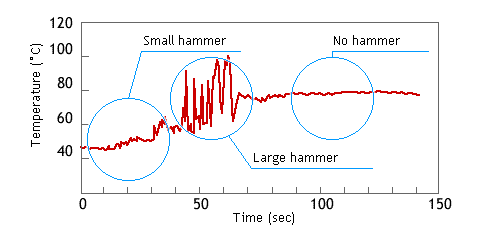Water hammer is formed due to the abrupt condensation of steam
When steam loses heat, it transforms into a liquid state with a volume less than 1000 times its gaseous state. As steam comes into contact with colder condensation and condenses, its volume decreases almost instantly. During condensation, the space occupied by the steam becomes a vacuum, which is gradually filled by the condensation water. Water hammer occurs when these walls of water collide, a phenomenon known as “steam-induced water hammer”

Thus, the mixing of cold condensation water and steam poses a danger to the pipes. However, this is standard in condensate recovery systems and similar systems, making this type of water hammer hard to prevent. Although steam-induced water hammer is limited to condensate recovery systems, it can also occur in steam distribution lines and steam-using equipment when condensation is not promptly drained.
Water Hammer Caused by High-Speed Condensation
Heat loss due to radiation causes the condensation of water inside steam pipes. From this chaos, condensation gradually forms and is carried along by the steam. The high-speed steam flow in the pipe pulls the condensation and causes waves, similar to how strong winds create tall waves. In this case, water hammer occurs when the condensation water flows through a bend or valve in the pipe.

How Does Condensation Temperature Affect Water Hammer?
Previously, it was believed that the lower the condensation temperature, the larger the water hammer. However, experiments at the Thang Long Boiler revealed a surprising fact. The most severe impact from a water hammer occurs when the condensation temperature is only slightly lower than the steam temperature. Specifically, at a steam temperature of 100°C, it was found that condensation between 70-80°C causes larger scale water hammer compared to condensation between 50-60°C.

In reality, the impact caused by a water hammer can be calculated mathematically, and the calculations reveal a close relationship between the intensity of the water hammer and the volume of condensed steam (referred to as “steam pockets”).
Examining the graph more closely, we can identify three condensation temperature zones:
- In the left zone of the graph, steam comes into contact with cold condensation and instantly condenses. In this case, condensation occurs on a scale of small steam bubbles, and large steam pockets do not form, hence only minor water hammer occurs.
- The middle zone of the graph is more concerning. Due to the small temperature difference between the condensation and steam (20-30°C), steam doesn’t condense all at once, but gradually. When the condensation process occurs slowly, it will reach a point where all steam condenses abruptly. The delay between the time the steam comes into contact with the condensation and the time it abruptly condenses allows larger steam pockets to form, and hence, a larger water hammer.
- In the right zone of the graph, steam comes into contact with condensation at the same temperature. In this case, the steam does not condense instantly, so no water hammer occurs. This confirms that water hammer does not appear at the outlet of steam traps, where saturated condensation coexists with pressure-expanded steam at the same temperature.
We know that condensation temperatures between 70-80°C increase the size of the steam pockets, causing the most severe water hammers. So, what triggers this process?
>> Causes and Locations.
Causes of Water Hammer Phenomenon
When the pump is operating normally and there is a sudden power outage, the pressure inside the pipeline increases rapidly. Massive shock waves are generated, affecting the entire system and the check valves. This phenomenon originates from three phases: the phase when the pump is operating normally, the phase of power loss and the impact of reverse pressure, and finally, the phenomenon of pump failure.
How to Mitigate Water Hammer Phenomenon
Central Control Panel: One of the solutions that Thang Long Boiler proposes is the use of a central control panel to reduce water supply pressure.
Slow-Closing Valves: Closing valves slowly is also an effective measure, minimizing the risk of water hammer formation.
High-Pressure Resistant Pipes: Using pipes that can withstand high pressure is a good way to prevent the phenomenon of water hammer.
Water Hammer Arrestors: Thang Long Boiler also recommends installing water hammer arrestors between the pipeline and machinery to absorb and halt pressure shocks.
Anti-Water Hammer Valves: Installing anti-water hammer valves or hydraulic pressure-reducing valves is also a safe and effective solution.
Thang Long Boiler not only provides technical solutions like installing water hammer arrestors or using high-pressure resistant pipes, but also focuses on raising awareness about the causes and formation mechanisms of water hammer. Only by fully understanding this issue can we apply solutions most effectively.
Thang Long Boiler’s solutions are a crucial step in minimizing risks and ensuring safety in pipeline systems. By combining technical knowledge with practical solutions, Thang Long Boiler ensures that you will not have to face the severe consequences of the water hammer phenomenon.

 Tiếng Việt
Tiếng Việt




